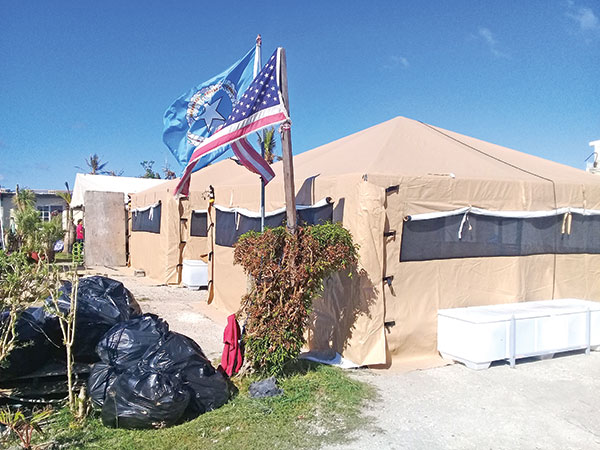458 tents installed on Saipan

U.S. and CNMI flags flap in the wind over two tents next to Antonia Aldan’s and her children’s houses on Knight Road in Susupe. (Ferdie de la Torre)
In just 30 minutes, Juan Yugummang and his family now have a tent that serves as their temporary shelter. It sits next to their rented house on Texas Road in Chalan Kanoa that was demolished by Super Typhoon Yutu’s fury.
According to Yugummang, U.S. military and CNMI Department of Fire and Emergency Medical Services personnel came to his place last week and installed the tent, which has the same look and color of military tents.
Yugummang and his wife, together with their six children, all fit inside the 16-by-16 tent, where they sleep at night with the aid of two electric fans. A generator provides them electric power.
“The tent is very helpful. It’s like a house. It’s waterproof,” Yugummang said, adding that mosquitoes could not enter the tent.
That, at least, solves a host of Yugummang’s pressing problems. He could focus now on how to rebuild his home due to lack of construction materials.
Yugummang went last week to the Koblerville Fire Station, where he asked the Federal Emergency Management Agency for a tent because his house’s roof had been blown away. After FEMA approved his request, U.S. military and DFEMS personnel came and installed the tent.
Members of the CNMI Department of Fire and Emergency Services, the Army Reserve and the Air Force assess homes and build tents for home owners after Super Typhoon Yutu destroyed their roofs, Oct. 24, 2018. Footage contains shots from Nov. 13, 14 and 17, 2018, relief efforts. (U.S. AIR FORCE/STAFF SGT. BETHANY LA VILLE)
Yugummang, who is originally from Yap, said that when they learned that Yutu was going to be strong enough to level their house, he and his family moved to his sister’s concrete house next to the Northern Marianas College.
When they returned the following morning, the tin roof of their house was gone.
Many of Yugummang’s neighbors also have similar experiences. Now, like Yugummang, they also have tents next to their homes.
Antonia Aldan, 67, got a tent; her son got one too.
The two tents were installed by military and DFEMS personnel last Friday next to Aldan’s house along Knight Road corner Texas Road in Susupe.
Near Aldan’s house are the homes of her son and her daughter. Aldan said her house has no roof anymore, while his two children’s houses were also severely damaged by Yutu.
She said the military installed the two tents in only 30 minutes.
Aldan, her husband, her daughter, and her son and his family would sleep in the two tents.
Aldan said it was her daughter-in-law and her other daughter who applied for the tents with FEMA, and provided them with two tents.
“It’s hot during daytime. But it’s good at night time, we got fresh air. Everything is closed so no mosquitoes,” she said.
Aldan said they would just unroll the cover of the window’s tent when it’s raining.
“It’s really helpful,” Aldan said.
The families have placed beds inside the tents.
Next to the tents, the U.S. and CNMI flags are erected on a small tree.
Many other houses near Aldan’s also have tents.
A resident of Koblerville who prefers to be called Jose said he was surprised to see a lot of military trucks in their area over the weekend.
Jose said many military tents were also put up in the village. “It’s like a war zone,” he said.
Yutu hit the CNMI last Oct. 24.
DFEMS spokesman Derek Gersonde said teamwork between FEMA, the CNMI government, the U.S. Air Force, and the U.S. Army has helped recovery efforts.
As of yesterday, 458 tents have been installed and they are installing more on the island.
Gersonde said DFEMS is setting up the tents with the Army Reserve and National Guard.
He said the Air Force is conducting the assessments, while DFEMS and Army Reserve and National Guard are setting up the tents.
Under the newly-created Temporary Emergency Tent and Roofing Installation Support program, or TETRIS, priority assistance is given to families whose homes sustained major damage or were completely destroyed by Yutu.
TETRIS, which was created through a collaboration between FEMA and the CNMI government, aims to help storm-impacted residents returning to or remaining in their homes while permanent repairs are being completed.



























